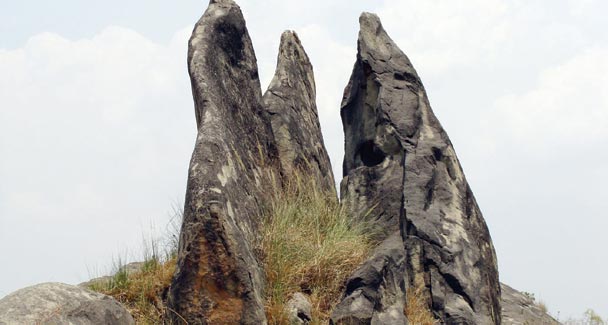Sacred
rocks of Islamabad
By Zulfiqar Ali Kalhoro
Sunday, 02
Aug, 2009 | 10:52 AM PST |

Three
natural menhirs at Peja village, Islamabad.—Photo by the writer
The territory of Islamabad abounds in prehistoric and
historic sites. Almost every village in Islamabad boasts of sites of historical
and archaeological significance.
During a survey of archaeological
sites and documentation of monuments in Rawalpindi and Islamabad by the research
team of Taxila Institute of Asian Civilizations of the Quaid-i-Azam University,
many prehistoric sites, later used by Hindus as sacred ground were identified.
One such site is located near the village of Bobri in Islamabad.
This site
is locally called Jira, where one finds rock shelters overlooking the dry Nullah.
As regards the term Jira, there are many possible theories; it could be the phonetic
variation of the word jatra or yatra meaning journey or pilgrimage to tirtha or
crossing place or some shrine dedicated to goddesses and gods of local origin
or fame. Another possible derivation of the word could be from Jiva, a Hindu deity.
One finds female garments offered to the deity when their wish was fulfilled.
Upon their first visit after marriage to such sites or shrines, they used to offer
their clothes to the deity. This custom is still widespread in some parts of Tharparkar,
particularly in Nagarparkar, Sindh, among the Megwal women who offer their clothes
to Sachia Devi.
A large number of china pottery and other utensils found
from the site show that the site was a sacred ground for the Hindus before partition.
Most of the china pottery pieces bear the swastika representation thus indicating
that it might have been the sacred space dedicated to Ganish because Swastika
sign is associated with this deity.
Such sites had always fascinated ancient
tribes who made shrines to invoke the help of the various deities.
During
the prehistoric period this site was used as shelter while hunting. Many stone
tools were found from the site. However, the most prominent stone tool was the
hand axe which was used for hunting.
There are two other sites which surround
the Bobri village where pots and stone tools are found. One such site is located
south of the village where there are two rock shelters. To the south-east of the
village is another ancient sacred site overlooking a nullah. This huge rock was
used as shelter by prehistoric humans. It is still used by the shepherds against
heat and rain.
Other sacred rocks are located in Phulgran village of Islamabad.
These natural menhirs and rock shelters overlook the agricultural fields. These
were invoked by ancient people before sowing. One finds some votive tables there
indicating that ancient people offered the tables to their gods whenever the crop
was good and in surplus.
A number of such sacred rocks are located in the
villages of Darwala, Bora Bangial, Peja, Gora Mast, Bhimbar Tarar and Bagh Jogian
where there are a number of sacred spaces for the performance of rituals by the
ancient as well as modern humans. The sacred rocks emerge from the Soan River
at Bagh Jogian and run North-South.
These rocks terminate at the village
of Peja in the shape of a three natural menhirs making a trinity. These menhirs
could be the trinity for the Hindus. These natural landscapes were domesticated
by ancient people through various rituals. Through the performance of various
rituals these natural landscapes were converted into cultural landscapes and a
number of shrines were made to magnify the power of the supernatural.
At
these rocks one also finds some geometric designs particularly triangles cut deep
into rocks possibly for appeasing the gods and the goddesses.
At Bagh Jogian,
literally meaning the garden of the Jogis, are located a number of caves and rock
shelters which were used by the followers of Nathism, a renunciatory order believed
to have been founded by Gorakh Nath. However, Naths, masters of the yogic powers,
consider Shiva as the original Nath and first guru. Bagh Jogian was once centre
of the Jogis. Formerly, there existed akharo (monastic establishment) of the Jogis
in the village who came here for ascetic practices (tapas) and other rituals.
Caves and rock shelters still can be seen near the southeast of the village of
Bagh Jogian where there are many sacred spaces used by Nath Jogis.
The
writer is a staff anthropologist in PIDE and PhD scholar at Taxila Institute of
Asian Civilisations, Quaid-i-Azam University, Islamabad. He can be reached at:
zulfi04@hotmail.com or re.isb@dawn.com